Research on Splash Lubrication Characteristics of a Spiral Bevel Gearbox Based on the MPS Method
Abstract
:1. Introduction
2. Numerical Methods
2.1. Governing Equations
2.2. Kernel Function and Particle Number Density
2.3. Particle Interaction Models
2.4. Boundary Conditions
2.5. Oil Churning Loss
3. Modeling and Simulation
3.1. Model of a High-Speed Train Gearbox and Simplification
- (1)
- Properly simplify minor and non-critical features such as chamfers and fillets on the gearbox casing, while retaining geometric characteristics inside the casing that influence the lubrication characteristics of the gearbox;
- (2)
- Remove the bolts on the surface of the casing and fill the bolt holes that have little effect on the flow field characteristics, making the inside surfaces of the casing flat and smooth.
3.2. Physical Parameters and Simulation Condition Settings
4. Experimental Verification
5. Results and Discussion
5.1. The Influence of Rotation Speed on the Lubrication Characteristics
5.2. The Effect of Initial Oil Volume on the Lubrication Characteristics
5.3. The Influence of Oil Temperature on the Lubrication Characteristics
5.4. Analysis of Churning Loss
6. Conclusions
- (1)
- The MPS method has been successfully used to visualize the internal flow field of the spiral bevel gear transmission gearbox, which provides a new method for the CFD research on complex models.
- (2)
- The number density and velocity nephogram of lubricating-oil particles of different simulation models have been extracted, and the lubrication characteristics of the gearbox qualitatively evaluated by the lubricating-oil particle distribution nephogram. The results indicate that as the gear rotation speed increases, the initial volume of lubricating oil rises, and the oil temperature decreases; additionally, more lubricating-oil particles are stirred up by the driven gear, leading to a more uniform distribution and higher lubricating-oil concentration in the gearbox. Moreover, the number of lubricating-oil particles stirred up by the driven gear in the gearbox is most affected by the initial lubricating-oil volume.
- (3)
- After post-processing the numerical results, the churning torque calculations and churning losses of different simulation models were obtained. The results show that the churning loss is positively correlated with the gear rotation speeds and the initial lubricating-oil volume, but negatively correlated with the oil temperature. Compared with the driving gear, the driven gear has a higher proportion of churning loss.
Author Contributions
Funding
Data Availability Statement
Conflicts of Interest
References
- Michaelis, K.; Höhn, B.-R.; Hinterstoißer, M. Influence factors on gearbox power loss. Ind. Lubr. Tribol. 2011, 63, 46–55. [Google Scholar] [CrossRef]
- Changenet, C.; Velex, P. A model for the prediction of churning losses in geared transmissions—Preliminary results. J. Mech. Design 2007, 129, 128–133. [Google Scholar] [CrossRef]
- Laruelle, S.; Fossier, C.; Changenet, C.; Ville, F.; Koechlin, S. Experimental investigations and analysis on churning losses of splash lubricated spiral bevel gears. Mech. Ind. 2017, 18, 412. [Google Scholar] [CrossRef]
- Quiban, R.; Changenet, C.; Marchesse, Y.; Ville, F.; Belmonte, J. Churning losses of spiral bevel gears at high rotational speed. Proc. Mech. Part J J. Eng. Tribol. 2019, 234, 172–182. [Google Scholar] [CrossRef]
- Polly, J.; Talbot, D.; Kahraman, A.; Singh, A.; Xu, H. An experimental investigation of churning power losses of a gearbox. J. Tribol. Trans. ASME 2018, 140, 031102. [Google Scholar] [CrossRef]
- Liu, H.; Jurkschat, T.; Lohner, T.; Stahl, K. Determination of oil distribution and churning power loss of gearboxes by finite volume CFD method. Tribol. Int. 2017, 109, 346–354. [Google Scholar] [CrossRef]
- Liu, H.; Jurkschat, T.; Lohner, T.; Stahl, K. Detailed investigations on the oil flow in dip-lubricated gearboxes by the finite volume CFD method. Lubricants 2018, 6, 47. [Google Scholar] [CrossRef]
- Chen, S.-W.; Matsumoto, S. Influence of relative position of gears and casing wall shape of gear box on churning loss under splash lubrication condition—Some new ideas. Tribol. Trans. 2016, 59, 993–1004. [Google Scholar] [CrossRef]
- Hildebrand, L.; Dangl, F.; Sedlmair, M.; Lohner, T.; Stahl, K. CFD analysis on the oil flow of a gear stage with guide plate. Forsch. Ingenieurwesen 2022, 86, 395–408. [Google Scholar] [CrossRef]
- Hu, X.; Wang, A.; Li, P.; Wang, J. Influence of dynamic attitudes on oil supply for bearings and churning power losses in a splash lubricated spiral bevel gearbox. Tribol. Int. 2021, 159, 106951. [Google Scholar] [CrossRef]
- Mastrone, M.N.; Concli, F. CFD simulation of grease lubrication: Analysis of the power losses and lubricant flows inside a back-to-back test rig gearbox. J. Non-Newton Fluid 2021, 297, 104652. [Google Scholar] [CrossRef]
- Liu, H.; Standl, P.; Sedlmair, M.; Lohner, T.; Stahl, K. Efficient CFD simulation model for a planetary gearbox. Forsch. Ingenieurwesen 2018, 82, 319–330. [Google Scholar] [CrossRef]
- Cho, J.; Hur, N.; Choi, J.; Yoon, J. Numerical simulation of oil and air two-phase flow in a planetary gear system using the overset mesh technique. In Proceedings of the 16th International Symposium on Transport Phenomena and Dynamics of Rotating Machinery, Honolulu, HI, USA, 10–15 April 2016. [Google Scholar]
- Burberi, E.; Fondelli, T.; Andreini, A.; Facchini, B.; Cipolla, L. CFD simulations of a meshing gear pair. In Proceedings of the ASME Turbo Expo 2016: Turbomachinery Technical Conference and Exposition, Seoul, Republic of Korea, 13–17 June 2016. [Google Scholar]
- Mastrone, M.N.; Hartono, E.A.; Chernoray, V.; Concli, F. Oil distribution and churning losses of gearboxes: Experimental and numerical analysis. Tribol. Int. 2020, 151, 106496. [Google Scholar] [CrossRef]
- Mastrone, M.N.; Concli, F. CFD simulations of gearboxes: Implementation of a mesh clustering algorithm for efficient simulations of complex system’s architectures. Int. J. Mech. Mater. Eng. 2021, 16, 12. [Google Scholar] [CrossRef]
- Mastrone, M.N.; Concli, F. A multi domain modeling approach for the CFD simulation of multi-stage gearboxes. Energies 2022, 15, 837. [Google Scholar] [CrossRef]
- Ji, Z.; Stanic, M.; Hartono, E.A.; Chernoray, V. Numerical simulations of oil flow inside a gearbox by Smoothed Particle Hydrodynamics (SPH) method. Tribol. Int. 2018, 127, 47–58. [Google Scholar] [CrossRef]
- Legrady, B.; Taesch, M.; Tschirschnitz, G.; Mieth, C.F. Prediction of churning losses in an industrial gear box with spiral bevel gears using the smoothed particle hydrodynamic method. Forsch. Ingenieurwesen 2022, 86, 379–388. [Google Scholar] [CrossRef]
- Liu, H.; Arfaoui, G.; Stanic, M.; Montigny, L.; Jurkschat, T.; Lohner, T.; Stahl, K. Numerical modelling of oil distribution and churning gear power losses of gearboxes by smoothed particle hydrodynamics. Proc. Mech. Part J J. Eng. Tribol. 2018, 233, 74–86. [Google Scholar] [CrossRef]
- Concli, F.; Gorla, C. Windage, churning and pocketing power losses of gears: Different modeling approaches for different goals. Forsch. Ingenieurwesen 2016, 80, 85–99. [Google Scholar] [CrossRef]
- Groenenboom, P.H.L.; Mettichi, M.Z.; Gargouri, Y. Simulating oil flow for gearbox lubrication using smoothed particle hydrodynamics. In Proceedings of the International Conference on High Performance Plastic Gears 2015, Garching, Germany, 5–7 October 2015. [Google Scholar]
- Liu, H.; Xie, C.; Li, D.; Wang, J. Flow field distribution of splash lubrication of gearbox and churning gear torque loss. J. Zhejiang Univ. 2021, 55, 875–886. [Google Scholar]
- Deng, X.; Wang, S.; Wang, S.; Wang, J.; Liu, Y.; Dou, Y.; He, G.; Qian, L. Lubrication mechanism in gearbox of high-speed railway trains. J. Adv. Mech. Des. Syst. 2020, 14, JAMDSM0054. [Google Scholar] [CrossRef]
- Xie, C.; Liu, H.; Jia, R.; Li, Q. Research on splash lubrication characteristics of two-stage gearbox based on MPS method. China Mech. Eng. 2021, 32, 1827–1835. [Google Scholar]
- Guo, D.; Chen, F.; Liu, J.; Wang, Y.; Wang, X. Numerical modeling of churning power loss of gear system based on moving particle method. Tribol. Trans. 2020, 63, 182–193. [Google Scholar] [CrossRef]
- Deng, X.; Wang, S.; Hammi, Y.; Qian, L.; Liu, Y. A combined experimental and computational study of lubrication mechanism of high precision reducer adopting a worm gear drive with complicated surface contact. Tribol. Int. 2020, 146, 106261. [Google Scholar] [CrossRef]
- Wei, C.; Wu, W.; Gui, P.; Zou, T.; Yuan, S.; Zhou, J. Analysis of churning losses distribution of hydraulic pump in engineering vehicles using MPS mechod. Proc. Mech. Part D J. Automb. Eng. 2023, 237, 1947–1958. [Google Scholar] [CrossRef]
- Wei, C.; Wu, W.; Hou, X.; Nelias, D.; Yuan, S. Research on flow pattern of low temperature lubrication flow field of rotating disk on MPS method. Tribol. Int. 2023, 180, 108221. [Google Scholar] [CrossRef]
- Hu, X.; Jiang, Y.; Luo, C.; Feng, L.; Dai, Y. Churning power losses of a gearbox with spiral bevel geared transmission. Tribol. Int. 2019, 129, 398–406. [Google Scholar] [CrossRef]
- Jiang, Y.; Hu, X.; Hong, S.; Li, P.; Wu, M. Influences of an oil guide device on splash lubrication performance in a spiral bevel gearbox. Tribol. Int. 2019, 136, 155–164. [Google Scholar] [CrossRef]
- Lu, F.; Wang, M.; Bao, H.; Huang, W.; Zhu, R. Churning power loss of the intermediate gearbox in a helicopter under splash lubrication. Proc. Mech. Part J J. Eng. Tribol. 2022, 236, 49–58. [Google Scholar] [CrossRef]
- Lu, F.; Wang, M.; Liu, W.; Bao, H.; Zhu, R. CFD-based calculation method of convective heat transfer coefficient of spiral bevel gear in intermediate gearbox under splash lubrication. Ind. Lubr. Tribol. 2021, 73, 470–476. [Google Scholar] [CrossRef]
- Lu, F.; Wang, M.; Pan, W.; Bao, H.; Ge, W. CFD-based investigation of lubrication and temperature characteristics of an intermediate gearbox with splash lubrication. Appl. Sci. 2021, 11, 352. [Google Scholar] [CrossRef]
- Peng, Q.; Gui, L.; Fan, Z. Numerical and experimental investigation of splashing oil flow in a hypoid gearbox. Eng. Appl. Comp. Fluid. 2018, 12, 324–333. [Google Scholar] [CrossRef]
- Peng, Q.; Zhou, C.; Gui, L.; Fan, Z. Investigation of the lubrication system in a vehicle axle: Numerical model and experimental validation. Proc. Mech. Part D J. Automob. Eng. 2019, 233, 1232–1244. [Google Scholar] [CrossRef]
- Peng, Q.; Zhou, C.; Gui, L.; Fan, Z. Investigation of the lubrication system in a vehicle axle: Optimization and experimental validation. Proc. Mech. Part D J. Automob. Eng. 2019, 233, 2096–2107. [Google Scholar] [CrossRef]
- Zhang, T. Theories and Applications of Moving Particle Semi-implicit Method; Harbin Institute of Technology Press: Harbin, China, 2019; pp. 4–13. [Google Scholar]
- Zhang, K.; Sun, Z.; Xi, G. Influence of the kernel function characteristics on the stability of pressure solution of moving particle semi-implicit method. J. Xi'an Jiaotong Univ. 2019, 53, 1–6. [Google Scholar]
- Xu, G. Research on Algorithm of Moving Particle Semi-Implicit Method. Master’s Thesis, Harbin Engineering University, Harbin, China, 2007. [Google Scholar]
- Hutter, K.; Wang, Y. Fluid and Thermodynamics. Advances in Geophysical and Environmental Mechanics and Mathematics; Springer International Publishing: Cham, Switzerland, 2016; pp. 263–316. [Google Scholar]
- AGMA 925-A03; Effect of Lubrication on Gear Surface Distress. American Gear Manufacturers Association: Alexandria, VA, USA, 2003; pp. 9–10.
- De Moura, C.A.; Kubrusly, C.S. The Courant-Friedrichs-Lewy (CFL) Condition: 80 Years after its Discovery; Birkhauser: Basel, Switzerland, 2012; pp. 37–38. [Google Scholar]

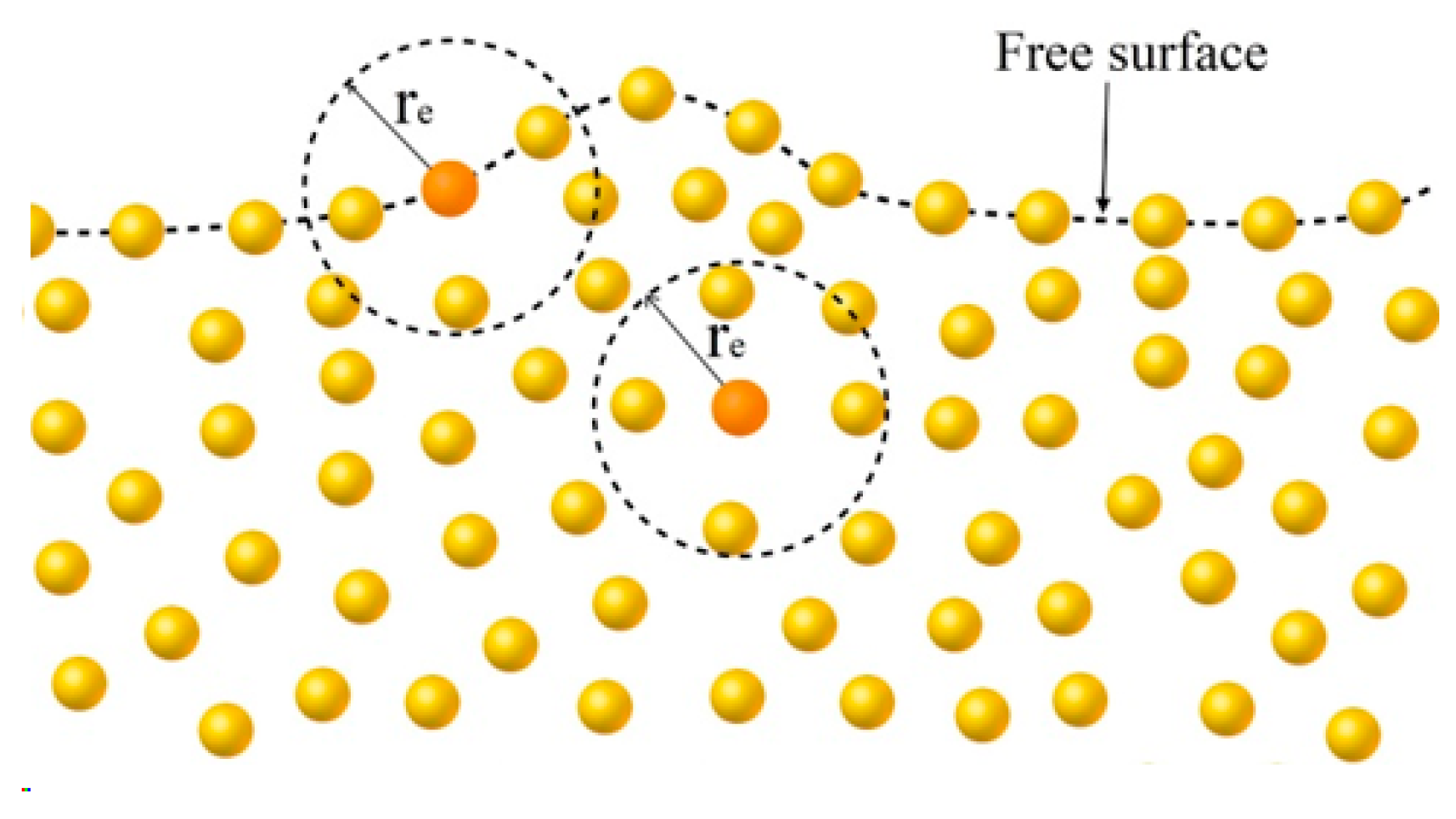
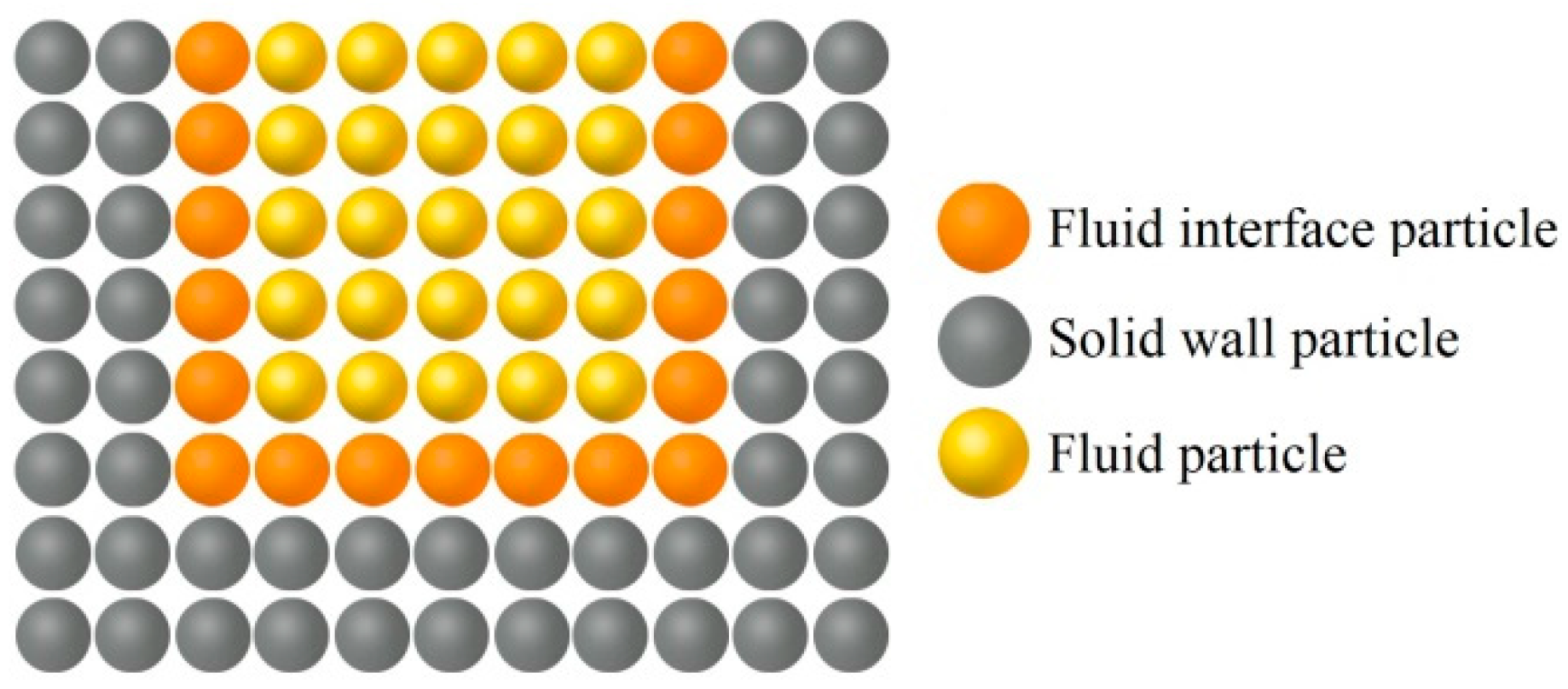

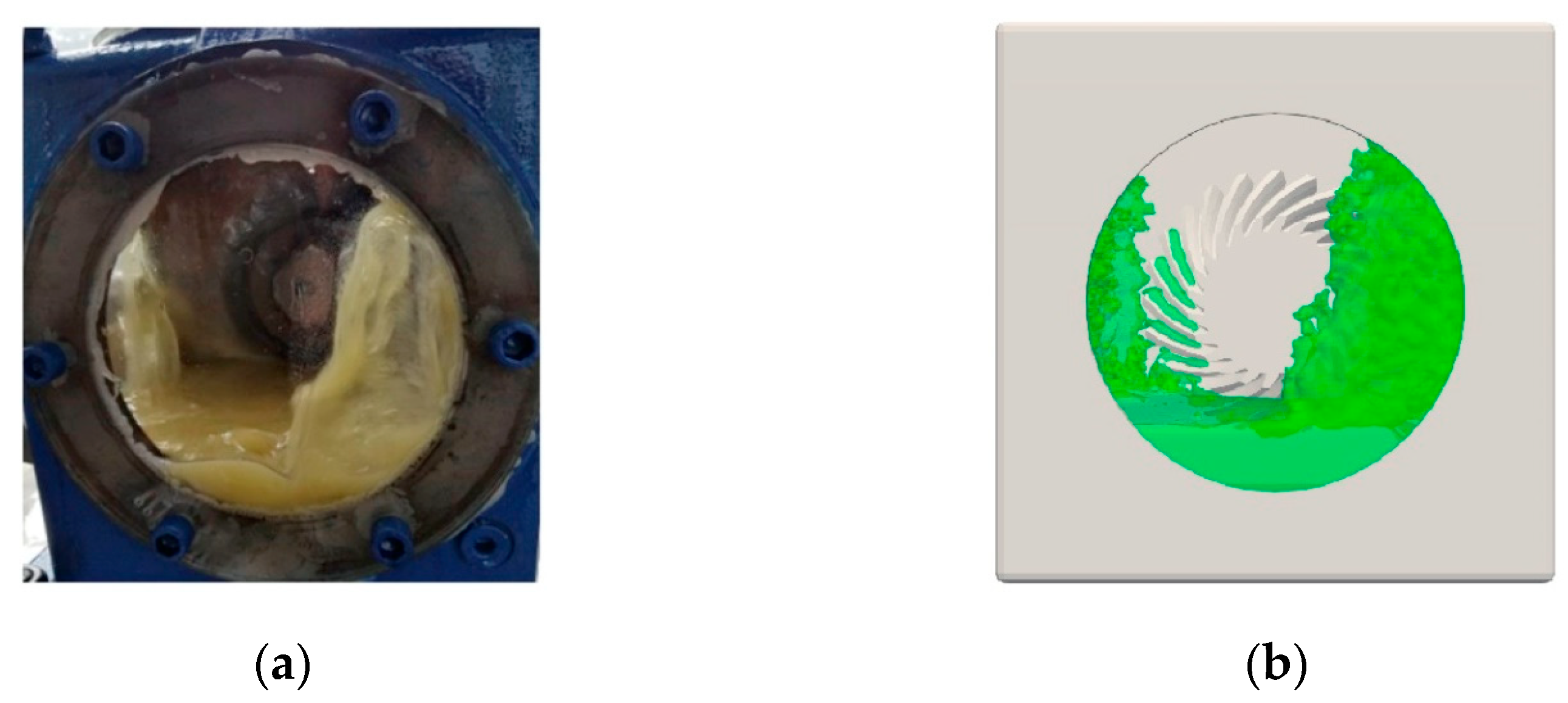
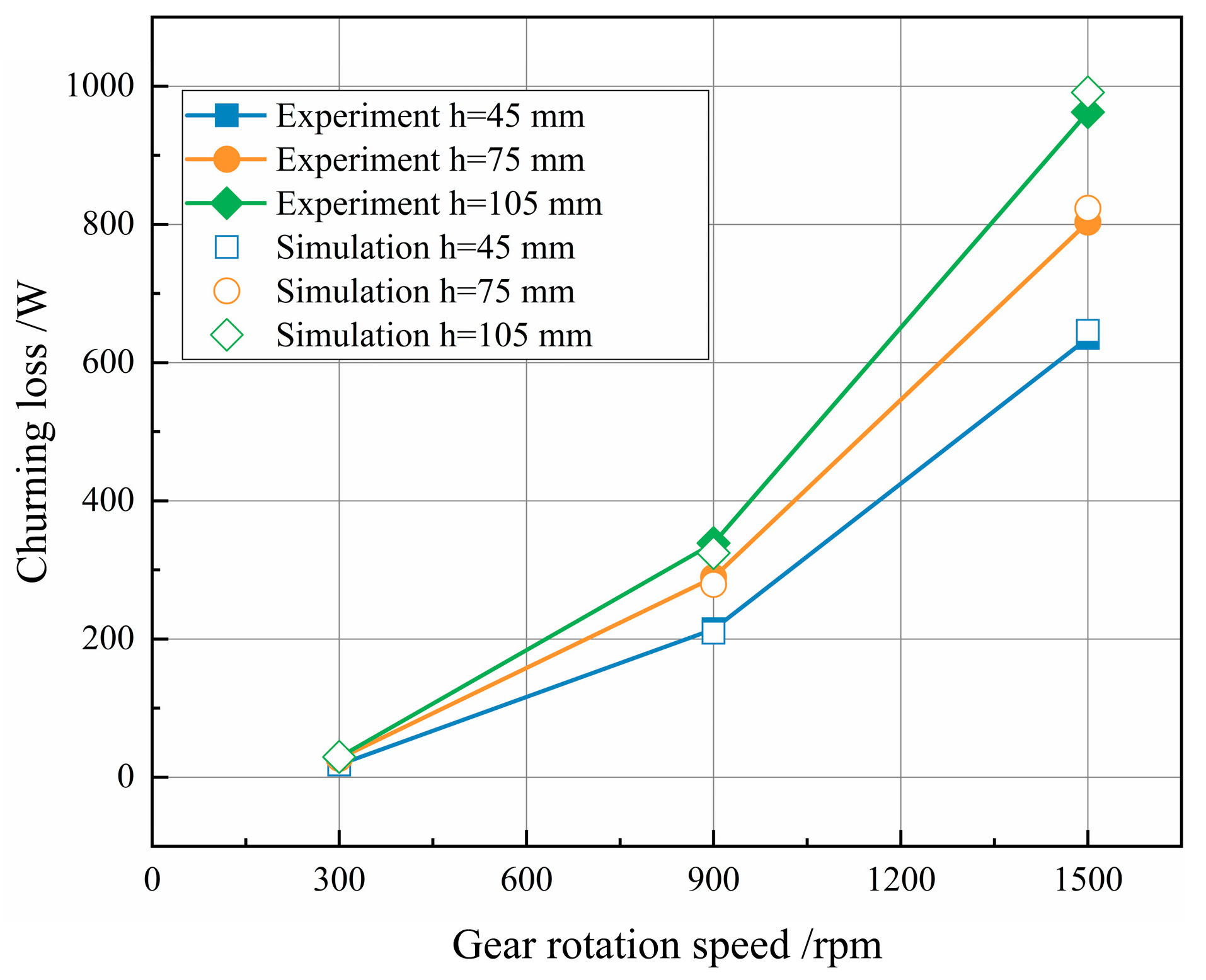







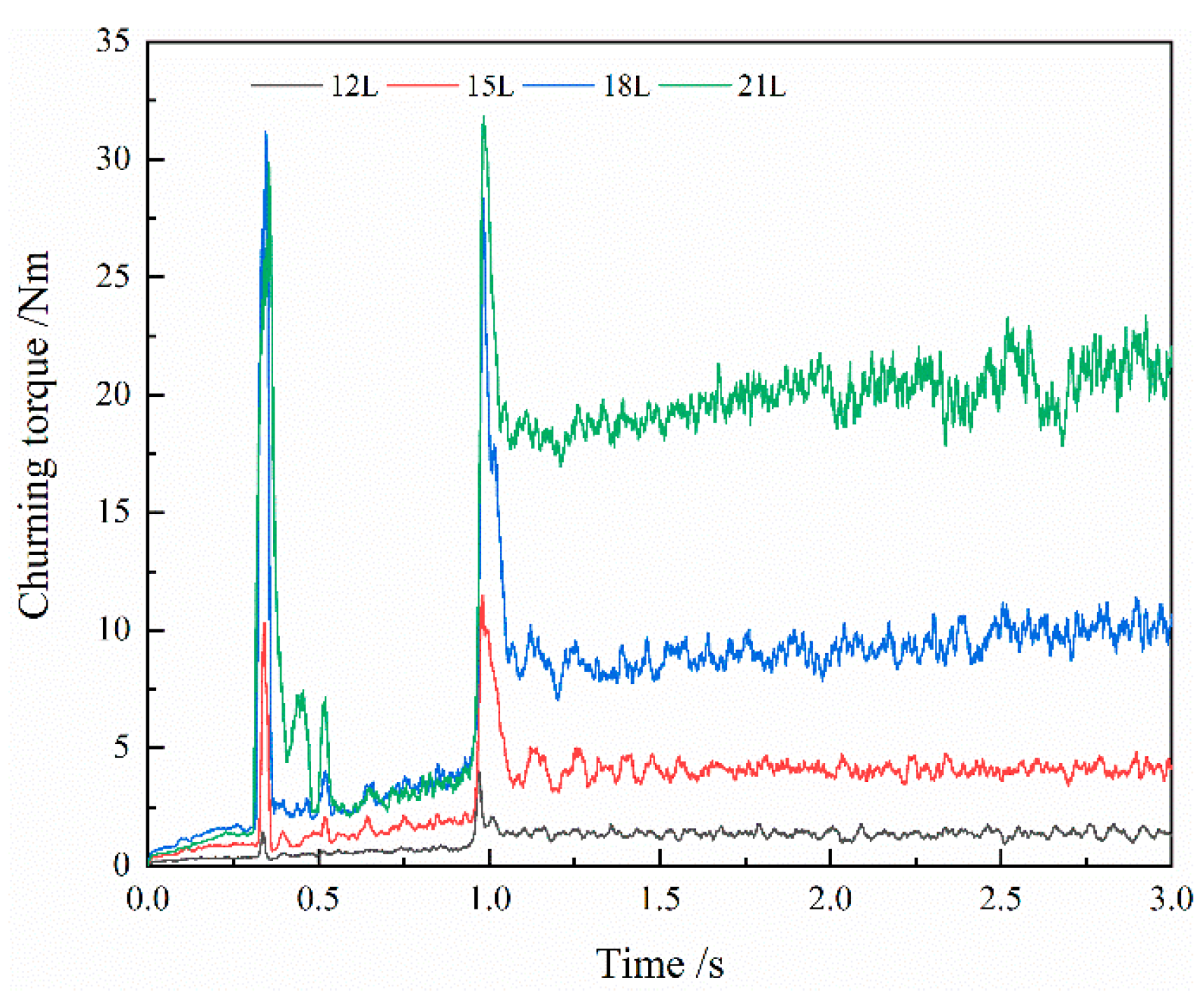


| Parameter | Driving Gear | Driven Gear |
|---|---|---|
| Tooth surface type | Gleason style | |
| Tooth number | 22 | 55 |
| Module/mm | 9.2 | |
| Tooth width/mm | 82 | |
| Pressure angle/° | 20 | |
| Helix angle/° | 30 | |
| Parameter | Value | Test Method |
|---|---|---|
| Density at 15 °C/(kg/m3) | 867 | DIN 51757 |
| Kinematic viscosity at 40 °C/(mm2/s) | 116 | ASTM D445 |
| Kinematic viscosity at 100 °C/(mm2/s) | 16.6 | ASTM D445 |
| Temperature (°C) | Density (kg/m3) | Kinematic Viscosity (mm2/s) |
|---|---|---|
| −25 | 891 | 17,676.99 |
| 0 | 876 | 1430.15 |
| 40 | 852 | 116.00 |
| 80 | 828 | 25.89 |
| Simulation Model | Driving Gear Rotation Speed (rpm) | Initial Oil Volume (L) | Oil Temperature (°C) |
|---|---|---|---|
| gk01 | 500 | 15 | 80 |
| gk02 | 1000 | ||
| gk03 | 1500 | ||
| gk04 | 2000 | ||
| gk05 | 2000 | 12 | 80 |
| gk06 | 18 | ||
| gk07 | 21 | ||
| gk08 | 2000 | 15 | −25 |
| gk09 | 0 | ||
| gk10 | 40 |
| Parameter | Value |
|---|---|
| Tooth number | 24/24 |
| Module (mm) | 6.5 |
| Tooth width (mm) | 40 |
| Pressure angle (°) | 20 |
| Axis shift angle (°) | 90 |
| Helix angle (°) | 35 |
| Churning Torque of Driving Gear (Nm) | Churning Torque of Driven Gear (Nm) | Churning Loss (W) | |
|---|---|---|---|
| gk01 | 0.05 | 0.81 | 19.37 |
| gk02 | 0.15 | 1.13 | 63.47 |
| gk03 | 0.39 | 1.99 | 186.59 |
| gk04 | 0.35 | 3.76 | 390.12 |
| gk05 | 0.07 | 1.30 | 124.31 |
| gk06 | 1.10 | 8.96 | 981.45 |
| gk07 | 3.83 | 16.27 | 2164.60 |
| gk08 | 0.56 | 7.29 | 728.23 |
| gk09 | 0.54 | 4.36 | 479.61 |
| gk10 | 0.41 | 3.77 | 403.40 |
Disclaimer/Publisher’s Note: The statements, opinions and data contained in all publications are solely those of the individual author(s) and contributor(s) and not of MDPI and/or the editor(s). MDPI and/or the editor(s) disclaim responsibility for any injury to people or property resulting from any ideas, methods, instructions or products referred to in the content. |
© 2023 by the authors. Licensee MDPI, Basel, Switzerland. This article is an open access article distributed under the terms and conditions of the Creative Commons Attribution (CC BY) license (https://creativecommons.org/licenses/by/4.0/).
Share and Cite
Shen, L.; Zhu, Y.; Shao, S.; Zhou, H.; Wang, Z. Research on Splash Lubrication Characteristics of a Spiral Bevel Gearbox Based on the MPS Method. Lubricants 2023, 11, 520. https://doi.org/10.3390/lubricants11120520
Shen L, Zhu Y, Shao S, Zhou H, Wang Z. Research on Splash Lubrication Characteristics of a Spiral Bevel Gearbox Based on the MPS Method. Lubricants. 2023; 11(12):520. https://doi.org/10.3390/lubricants11120520
Chicago/Turabian StyleShen, Longjiang, Yingmou Zhu, Shuai Shao, Huajin Zhou, and Zhengyang Wang. 2023. "Research on Splash Lubrication Characteristics of a Spiral Bevel Gearbox Based on the MPS Method" Lubricants 11, no. 12: 520. https://doi.org/10.3390/lubricants11120520
APA StyleShen, L., Zhu, Y., Shao, S., Zhou, H., & Wang, Z. (2023). Research on Splash Lubrication Characteristics of a Spiral Bevel Gearbox Based on the MPS Method. Lubricants, 11(12), 520. https://doi.org/10.3390/lubricants11120520




